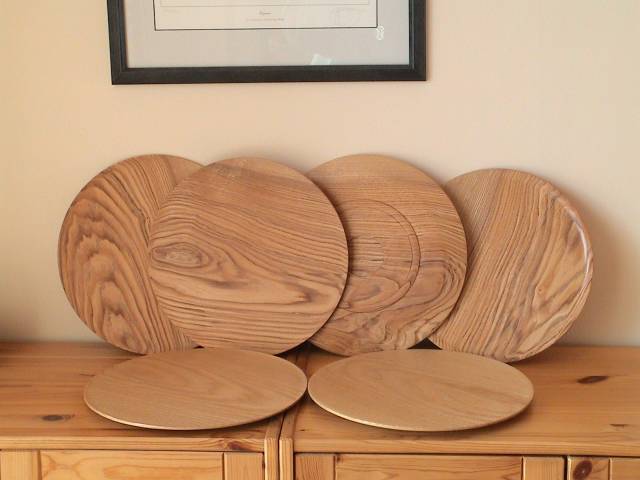TobyB
Established Member
I had problems with my first go at a 3-legged "milking" stool, and the advice here that the piece of horse chestnut wasn't a great choice proved worthwhile ... tried again with a piece of olive ash and it came out OK ... although finding smooth curves/flats on larger surfaces difficult.
But, since this was a first go, and thought I might make a few more, perhaps some 4-leg versions, and also would like to make a small "occasional" table too ... I'd like to know about making the tops.
My method seems very wasteful of wood. I'd picked out a largish bowl (or perhaps platter) blank perhaps 30-35 cms diameter and about 6 cms thick. Screwed it onto a faceplate using as shorter screws as I dared - about 8-10mm of bite. Trued and partially shaped the edge, flattened the base, cut a recess in the base for a chuck and some more cuts inside of that to make it appear decorative, then sanded and finished that side. Used the index and a jig to drill 2cms holes for the legs. Took it off the faceplate and mounted it on the chuck. Cut away loads of wood - 1 cms at least - to loose the screw holes - then finished the top face and edge, sanded and finished, etc.
So - the 6 cm blank ends up about 4 cms thick in the end. On a stool, where I wanted enough thickness to securely mount the legs, that's OK. But if I wanted to make something a little larger ... a 40-50 cms tabletop that I only want a couple of cms thick ... it's expensive to throw a third of that away because of the faceplate screwholes.
Is there a better way? I wondered about the idea I've seen of gluing a bit of waste on ... but only seen this illustrated for small projects ... didn't fancy a heavy stool/tabletop flying across the workshop when the glued interface shears!
One other question ... for a stool a curved edge and gently dished seat was OK. But how would I get the best flat tabletop ... scrape and then sand a lot? Bowl gouge? Plane it on the bench when the shape is made?
Maybe this is all obvious to the assembled masses of experienced experts out there, but it's not to me, and the books on bowls, boxes, hollowing, etc don't touch on this much ...
Cheers
Toby
But, since this was a first go, and thought I might make a few more, perhaps some 4-leg versions, and also would like to make a small "occasional" table too ... I'd like to know about making the tops.
My method seems very wasteful of wood. I'd picked out a largish bowl (or perhaps platter) blank perhaps 30-35 cms diameter and about 6 cms thick. Screwed it onto a faceplate using as shorter screws as I dared - about 8-10mm of bite. Trued and partially shaped the edge, flattened the base, cut a recess in the base for a chuck and some more cuts inside of that to make it appear decorative, then sanded and finished that side. Used the index and a jig to drill 2cms holes for the legs. Took it off the faceplate and mounted it on the chuck. Cut away loads of wood - 1 cms at least - to loose the screw holes - then finished the top face and edge, sanded and finished, etc.
So - the 6 cm blank ends up about 4 cms thick in the end. On a stool, where I wanted enough thickness to securely mount the legs, that's OK. But if I wanted to make something a little larger ... a 40-50 cms tabletop that I only want a couple of cms thick ... it's expensive to throw a third of that away because of the faceplate screwholes.
Is there a better way? I wondered about the idea I've seen of gluing a bit of waste on ... but only seen this illustrated for small projects ... didn't fancy a heavy stool/tabletop flying across the workshop when the glued interface shears!
One other question ... for a stool a curved edge and gently dished seat was OK. But how would I get the best flat tabletop ... scrape and then sand a lot? Bowl gouge? Plane it on the bench when the shape is made?
Maybe this is all obvious to the assembled masses of experienced experts out there, but it's not to me, and the books on bowls, boxes, hollowing, etc don't touch on this much ...
Cheers
Toby


































